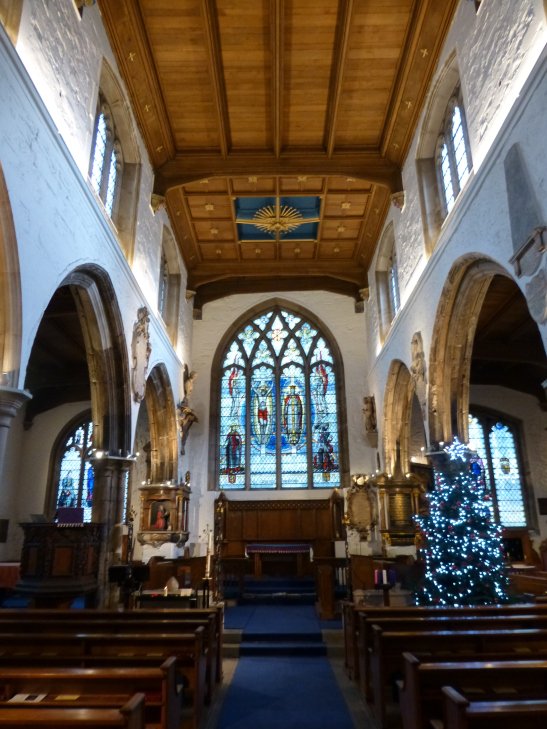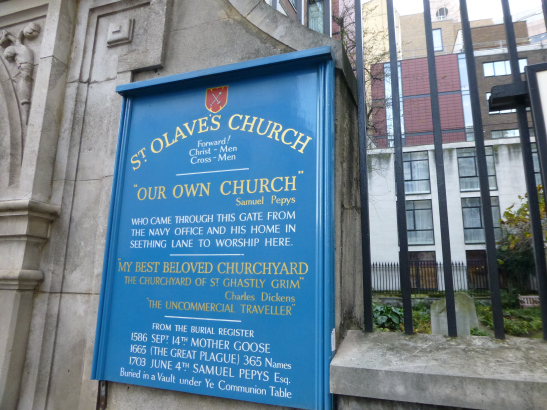St Olave Hart Street ~ Samuel Pepys’ church & one of six Great Fire Survivors
Located a short walk from the Tower of London is this wonderful church that is one of the few medieval buildings in the City that survived the Great Fire of London. Tucked away on the corner of Hart St and Seething Lane, this pleasant church offers free weekday music recitals, excellent architecture and a fascinating history, not least of which is that it was Samuel Pepys’ church and his place of burial. The church also has links to various historic City organizations, Norway, and even Queen Elizabeth I.
History: The first recorded history of the church is from the 13th Century when a stone building was erected here, likely replacing a wooden building that supposedly was built on the site of the Battle of London Bridge, fought in 1014 between the combined forces of English King Ethelred and Norwegian King Olaf II against the invading Danish army. King Olaf II was canonised after his death, become the patron Saint of Norway, and his name was chosen for this church given its location. During WWII King Haakon VII of Norway worshiped here while living in exile in London, furthering the Norwegian connection.
Much of the original church from a rebuilding in 1450 survives, though the tower was added in 1732 along with some serious marble polishing. While the church did survive the Great Fire with some help (see below), it was badly damaged during WWII. In 1941 an incendiary bomb fell on the tower and the intensity of the fire melted the peal of all eight bells. The metal was recovered and returned to the historic Whitechapel Bell Foundry who recast the metal to recreate the bells as they had originally made them 300 years earlier (to hear an audio file of the bells ringing click here ). The bombing damage required a restoration, which was completed by 1954 and the reopening dedication was attended by the aforementioned King Haakon VII. Now a Grade I listed building (as of 1950), the church is well worth a visit.
Of note, St. Olave’s is the Ward Church for the Tower Ward of the City and also the home chapel for the Clothworkers’ Company, Trinity House and the Environmental Cleaners’ Company.
Samuel Pepys: Arguably best known for the diary he wrote from 1660-1669 which covered the both the Great Plague and Great Fire, Pepys held roles as a Member of Parliament and Secretary to the Admiralty. Both his own home and the Naval office he worked in were on Seething Lane and thus St. Olave’s become his “own church” (per his diary). He even arranged for a connecting stairway from the Naval offices to the church so he could easily attend services (remembered via a stone inscription on the outside of the church showing the location of this entrance). First his wife was buried at St. Olave’s in 1669, and then Pepys himself was buried here in 1703.
Notable People Associated with St. Olave’s: Queen Elizabeth I attended a service here immediately following her release from the Tower of London in 1554 to celebrate her release. William Penn, the father of younger Wm Penn who founded Pennsylvania, worked at the neighbouring naval yards. He organized the protection of the church in 1666 by destroying the houses that surrounded the church to create a fire break. Charles Dickens found the skulls in the stone archway entrance to the graveyard fascinating and calling it “St. Ghastly Grim” included it in his book “Uncommercial Traveller”. Lastly, the graveyard contains several other people of interest, including ‘Mother Goose’ (still remembered via pantomime) buried in 1586 and Mary Ramsay, who purportedly brought the plague to London in 1665.
Free Concerts: Most Wednesdays and Thursdays at 1:05pm there is a free music recital at St. Olave. These are commonly piano recitals, but will occasionally have stringed instruments. See stolave.weebly.com for full details of upcoming events.
Visiting: St Olave is open weekdays 9am-5pm. Services are on the 1st and 3rd Sunday each month at 11am, and on Tuesdays at 12:30pm. There is a special service on the Sunday closest to St. Olave’s Day (29 July).
Located at: 8 Hart Street, London, EC3R 7NB
Closest Tube: Tower Hill
One comment on “St Olave Hart Street ~ Samuel Pepys’ church & one of six Great Fire Survivors”
Leave a Reply
Recommended reading
- Migliori Casino Online
- Migliori Casino Online
- Casino Non Aams Italia
- Casinos Not On Gamstop
- UK Online Casinos Not On Gamstop
- Casino Sites Not On Gamstop
- Casino Sites Not On Gamstop
- Non Gamstop Casino
- Casinos Not On Gamstop
- Non Gamstop Casinos UK
- Best Non Gamstop Casinos
- Meilleur Casino En Ligne France
- Non-gamstop UK Casinos
- UK Gambling Sites Not On Gamstop
- Casino Sites In UK
- Casinos Not On Gamstop
- Non Gamstop Casinos
- Sites Not On Gamstop
- Meilleur Site De Casino En Ligne
- Casino En Ligne Fiable
- Non Gamstop Casinos
- UK Betting Sites
- Non Gamstop Casino Sites UK
- Non Gamstop Casino UK
- Casino Online Non Aams
- Casino Non Aams Sicuri
- Sites De Paris Sportifs En Belgique
- Meilleur Casino Belgique En Ligne
- Meilleur Site De Casino En Ligne Belgique
- Casino En Ligne
- 비트코인 베팅사이트
- Site De Casino En Ligne








As visitors we love this wonderful icon of London’s history & since we are in London during Christmas we make it a yearly tradition to attend the services- always a warm welcome from all the parishioners for their visitors from the U.S.!